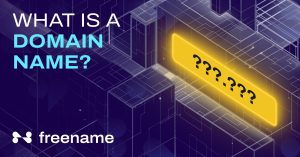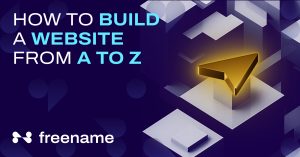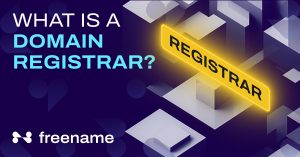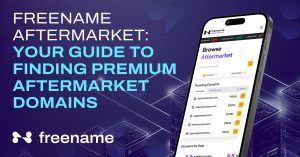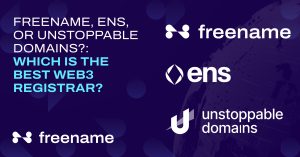Today, Web3 domains are giving a tough competition to the centralized domain registrars in terms of popularity. These blockchain-powered domains introduce users to decentralized applications and online identities.
The US Web3 market is anticipated to hit $81.5 billion by 2030 at 43.7% of CAGR from 2022 to 2030, according to Emergen Research. Considering this growing popularity, many countries, such as Brazil, UK, and Singapore, have developed regulatory frameworks to govern Web3 domains.
Most of these rules focus on the societal, environmental, and economical impact of the growing technology. In fact, many states in the US, such as Wyoming, have introduced their own Web3 regulations. These rules offer special privileges to businesses that comply with the Web3 domain ordinance.
Despite the lack of blockchain and Web3 regulations in many countries, many are increasingly adopting Web3 regulations. In this article, we will explore the global regulatory trends shaping the Web3 landscape.
Global Regulations Around Web3 Domains
Gavin Wood introduced “Web3” in 2014, but the concept became popular in 2021. It is still in the initial stage and needs more awareness to be used fairly and safely. That is why there are rising concerns about its use.
In this rapidly evolving tech world, individual users and companies operating in the blockchain or Web3 space may fall prey to scams or malicious activities. It’s important to stay abreast of the latest regulations to operate safely.
Here are some prominent global regulations and licensing trends affecting Web3 domains today:
| Law | Goal | Launch Date |
| EU Data Act | To improve data accessibility and promote a competitive cloud market in Europe | January 2024 |
| United States | To regulate the market on multiple levels | Not a single law, a series of rules |
| Canada | To regulate the market on multiple levels | Not a single law, but involvement from federal authorities |
| Brazil’s Crypto Assets Act | To regulate virtual asset mechanisms | Published in December, 2022, but came into force on June 20, 2023 |
| UK & Singapore Financial Dialogue | To support international standards around digital assets | July 26, 2023 |
| India’s G20 Presidency Note | To minimize financial stability risks and ensure investor protection | August 1, 2023 |
| Responsible Financial Innovation Act (RFIA) | To support digital asset innovation and stablecoins framework | April 17, 2024 |
| Oman’s Regulatory Framework | To regulate virtual asset transactions | July 27, 2023 |
| UAE’s Virtual Asset Regulation Law | To increase awareness on investment | March 9, 2022 |
EU Data Act
The European Data Act, adopted in January 2024, is a legislation designed to enhance the EU’s data economy by improving data accessibility and promoting a competitive cloud market in Europe. It builds on the European data strategy to create a unified European data space, encouraging efficient data pooling, sharing, and utilization. The Act also facilitates data sharing from connected devices, protects against unfair contracts, and ensures the public sector can access private sector data during emergencies. Thierry Breton, Commissioner for the EU’s internal market, hailed the legislation as a “milestone in reshaping the digital space,” predicting it will foster a “thriving data economy that is innovative and open—on our terms.”
Implications for Web3 and Blockchain:
- Data Protection: The Act increases transparency, mandates consent-based data processing, and enhances individual control over data. Companies in these sectors will need to adopt robust data governance frameworks and secure consent for data usage.
- Innovation Opportunities: Compliance with the Data Act can help companies build trust, creating opportunities to develop new solutions that balance data privacy with the advantages of emerging technologies.
- Data Usage: Companies must ensure they comply with regulations regarding the types of data they can use and the management of personal user information.
Web3 Regulations in The United States
In the United States, the regulatory landscape for Web3 technologies is complex and fragmented, with various federal and state agencies playing a role.
- Securities and Exchange Commission (SEC): The SEC has been actively involved in regulating cryptocurrencies and initial coin offerings (ICOs). The agency considers many tokens as securities and requires them to comply with securities laws, which include registration and disclosure requirements.
- Commodity Futures Trading Commission (CFTC): The CFTC oversees derivatives markets and has classified Bitcoin and Ethereum as commodities. It regulates futures and options markets for these assets.
- Financial Crimes Enforcement Network (FinCEN): FinCEN focuses on anti-money laundering (AML) and counter-terrorism financing (CTF) regulations. It requires cryptocurrency exchanges and certain wallet providers to register as money services businesses (MSBs) and adhere to strict reporting and compliance standards.
- State Regulations: Individual states have their own regulations, such as New York’s BitLicense, which imposes stringent requirements on cryptocurrency businesses operating within the state.
Web3 Regulations in Canada
Canada’s approach to Web3 regulation is more centralized compared to the U.S., with significant involvement from federal authorities.
- Canadian Securities Administrators (CSA): The CSA provides guidelines on how securities laws apply to cryptocurrencies and ICOs. It emphasizes that many digital assets are considered securities and must comply with relevant laws.
- Financial Transactions and Reports Analysis Centre of Canada (FINTRAC): Similar to FinCEN in the U.S., FINTRAC enforces AML and CTF regulations. Cryptocurrency exchanges must register with FINTRAC and adhere to reporting and compliance obligations.
- Bank of Canada: The central bank is exploring the potential for a digital Canadian dollar (CBDC), which could coexist with cryptocurrencies and provide a regulated digital payment option.
- Provincial Regulations: Like the U.S., provinces in Canada have their own regulatory frameworks. For instance, the Ontario Securities Commission (OSC) has been proactive in regulating cryptocurrency trading platforms.
Brazil’s Crypto Assets Act
Brazil published the “Crypto Assets Act” (also known as the Legal Framework for Virtual Assets) in December 2022. However, it came into force on June 20, 2023, as the country’s Law No. 14,478. The law defines guidelines for virtual asset regulatory mechanisms, such as prior authorization, virtual asset service provider (VASP) services, guiding rules, and criminal responsibilities for fraud.
The act includes a wide range of virtual assets. Still, it excludes electronic money, national and foreign currencies, loyalty program rewards, and other assets that existing laws in the country already regulate.
For crypto asset securities, the Securities and Exchange Commission of Brazil (CVM) outlines the circumstances in which crypto assets can be considered securities. On the other hand, the Banco Central do Brasil (BCB) is responsible for monitoring virtual asset services.
UK & Singapore Financial Dialogue
The Web3 domain demands a collaborative ground among countries to ensure safe international operations. On July 26, 2023, the UK and Singapore agreed on the 8th UK-Singapore Financial Dialogue to support international standards in the digital asset space, including sustainable finance, crypto, digital assets, and CBDCs.
The dialogue also aims to support CBDC research and experiment and national crypto regulations.
India’s G20 Presidency Note
The Web3 domain calls for regulations around financial stability risks, technological innovation support, and investor protection and education. That’s what India’s G20 Presidency Note on crypto, published on August 1, 2023, is all about. It is an effort to contribute to global crypto regulations.
The Indian government plans to achieve its goals through the International Monetary Fund (IMF) & the Financial Stability Board (FSB)’s upcoming synthesis paper. It will establish a “minimum global policy standard” for crypto assets as part of the “Roadmap on Establishing a Global Framework for Crypto Assets.”
Responsible Financial Innovation Act (RFIA)
Introduced on April 17, 2024, RFIA or Lummis-Gillibrand Crypto Bill revolves around ensuring responsible financial innovation. It is focused on the regulatory perimeter around digital assets and stablecoins framework.
The law is regulated by the Commodity Futures Trading Commission (CFTC).
Oman’s Regulatory Framework
Making transactions through virtual assets in the Web3 space requires strict regulations for transparency and protection. Pertaining to this, the Capital Market Authority (CMA) of Oman started a public consultation process on July 27, 2023 to collect input for its Visual Asset (VA) and Virtual Asset Service Providers (VASP) regulatory framework.
These regulations establish a comprehensive and updated set of rules for addressing potential risks associated with virtual asset transitions.
UAE’s Virtual Asset Regulation Law
UAE introduced the Virtual Asset regulation law on March 9, 2022, to promote innovation in the virtual asset sector. The law defines the nature of digital assets as a medium for storage, exchange, and owner’s account representation, which can be transferred electronically from one person to another.
The main goal of this law is to increase awareness of investments in virtual asset services and products. It is regulated by the Securities and Commodities Authority (SCA) and The Dubai Virtual Assets Regulatory Authority (VARA).
Web3 Domain Licenses for Regulatory Compliance
Many crypto exchanges and Web3 domain providers have obtained licenses to fully operate globally in different countries. Here are some prominent ones:
- Binance MVP Operational License. Binance got its operating license under the Malta Virtual Financial Assets (VFA) Act. This Maltese law makes Binance, one of the largest crypto exchanges, a fully-regulated entity, which boosts its credibility in the global market.
- HashKey Exchange License. HashKey Exchange is the first-ever licensed virtual asset exchange for Hong Kong retailers. It has obtained an uplift of Type 1 and Type 7 licenses.
- CoinMENA Crypto Exchange. Licensed by Bahrain and the European Union (EU), CoinMENA is one of the few fully regulated Middle Eastern crypto exchanges. It currently has more than 250,000 users with future plans for expansion.
- Laser Digital. Laser Digital is a Swiss crypto services provider licensed by Dubai’s Virtual Asset Regulatory Authority (VARA). This allows the company to offer fully compliant crypto investment services in the UAE.
Understanding Web3 Global Regulations To Stay Ahead
As the Web3 domain rapidly evolves, staying informed about legal and regulatory trends is essential. By keeping up-to-date, individuals and companies can navigate the virtual asset and crypto ecosystem safely and effectively. These laws not only ensure safe operations but also prioritize investor protection and securities compliance, fostering a secure and trustworthy digital environment. Stay ahead, stay informed, and thrive in the world of Web3.


